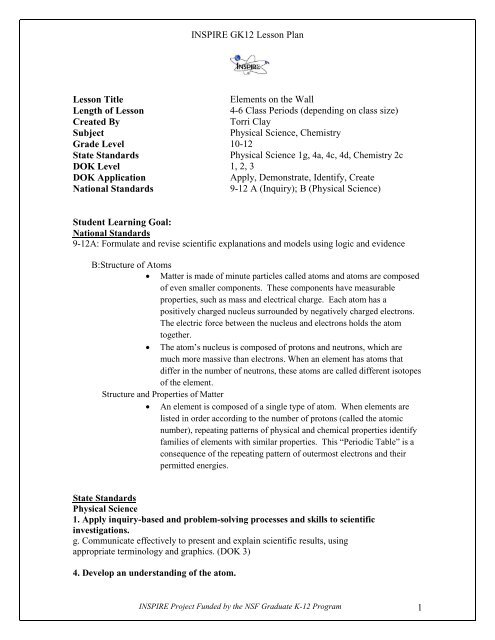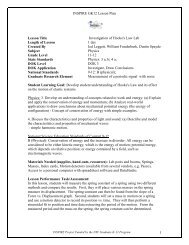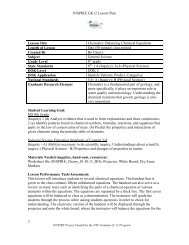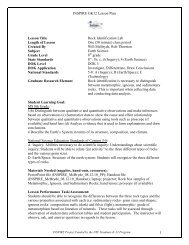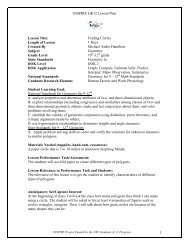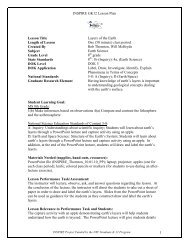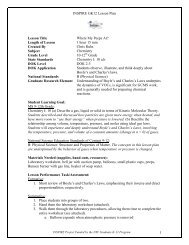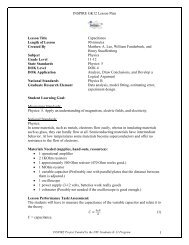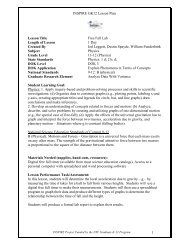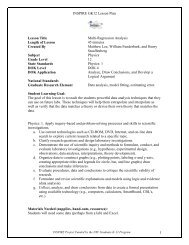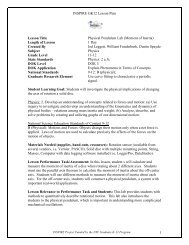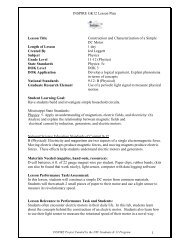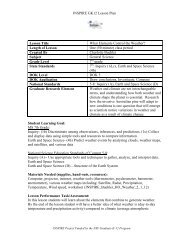INSPIRE GK12 Lesson Plan
INSPIRE GK12 Lesson Plan
INSPIRE GK12 Lesson Plan
Create successful ePaper yourself
Turn your PDF publications into a flip-book with our unique Google optimized e-Paper software.
<strong>INSPIRE</strong> <strong>GK12</strong> <strong>Lesson</strong> <strong>Plan</strong><strong>Lesson</strong> TitleElements on the WallLength of <strong>Lesson</strong>4-6 Class Periods (depending on class size)Created ByTorri ClaySubjectPhysical Science, ChemistryGrade Level 10-12State StandardsPhysical Science 1g, 4a, 4c, 4d, Chemistry 2cDOK Level 1, 2, 3DOK ApplicationApply, Demonstrate, Identify, CreateNational Standards9-12 A (Inquiry); B (Physical Science)Student Learning Goal:National Standards9-12A: Formulate and revise scientific explanations and models using logic and evidenceB:Structure of Atoms Matter is made of minute particles called atoms and atoms are composedof even smaller components. These components have measurableproperties, such as mass and electrical charge. Each atom has apositively charged nucleus surrounded by negatively charged electrons.The electric force between the nucleus and electrons holds the atomtogether. The atom’s nucleus is composed of protons and neutrons, which aremuch more massive than electrons. When an element has atoms thatdiffer in the number of neutrons, these atoms are called different isotopesof the element.Structure and Properties of Matter An element is composed of a single type of atom. When elements arelisted in order according to the number of protons (called the atomicnumber), repeating patterns of physical and chemical properties identifyfamilies of elements with similar properties. This “Periodic Table” is aconsequence of the repeating pattern of outermost electrons and theirpermitted energies.State StandardsPhysical Science1. Apply inquiry-based and problem-solving processes and skills to scientificinvestigations.g. Communicate effectively to present and explain scientific results, usingappropriate terminology and graphics. (DOK 3)4. Develop an understanding of the atom.<strong>INSPIRE</strong> Project Funded by the NSF Graduate K-12 Program 1
<strong>INSPIRE</strong> <strong>GK12</strong> <strong>Lesson</strong> <strong>Plan</strong>a. Cite evidence to summarize the atomic theory. (DOK 1) Models for atoms Building blocks of matter (e.g., proton, neutron, and electron) and elementaryparticles (e.g., positron, mesons, neutrinos, etc.)c. Research the history of the periodic table of the elements and summarize thecontributions which led to the atomic theory. (DOK 2) Contributions of scientists (e.g., John Dalton, J.J. Thomson, Ernest Rutherford,Newton, Einstein, Neils, Bohr, Louis de Broglie, Erwin Schrödinger, etc.) Technology (e.g., x-rays, cathode-ray tubes, spectroscopes) Experiments (e.g., gold-foil, cathode-ray, etc.)d. Utilize the periodic table to predict and explain patterns and drawconclusions about the structure, properties, and organization of matter. (DOK 2) Atomic composition and valence electron configuration (e.g., atomic number, massnumber of protons, neutrons, electrons, isotopes, and ions) Periodic trends using the periodic table (e.g., valence, reactivity, atomic radius) Average atomic mass from isotopic abundance Solids, liquids, and gases Periodic properties of elements (e.g., metal/nonmetal/metalloid behavior,electrical/heat conductivity, electronegativity, electron affinity, ionization energy,atomic/covalent/ionic radius) and how they relate to position in the periodic tableChemistry2. Demonstrate an understanding of the atomic model of matter by explainingatomic structure and chemical bonding.c. Develop a model of atomic and nuclear structure based on theory andknowledge of fundamental particles. (DOK 2)Properties and interactions of the three fundamental particles of the atomLaws of conservation of mass, constant composition, definite proportions, andmultiple proportionsMaterials Needed (supplies, hand-outs, resources): Reference materials (periodic table, internet access, books) Various materials for students to construct their tiles (glue, scissors, coloredpaper, glitter, paint, etc.) Paper (11” x 17” or chosen size) Computer (for students to complete their powerpoint) "Elliott's" Elements Grade Sheet "Elliott's" Elements Presentation Rubric "Elliott's" Elements Presentation Score Sheet<strong>INSPIRE</strong> Project Funded by the NSF Graduate K-12 Program 2
<strong>INSPIRE</strong> <strong>GK12</strong> <strong>Lesson</strong> <strong>Plan</strong>**The rubric, score sheet, and grade sheet, along with pictures, detailed instructions and examplescan be found at the following web address:http://www.scsc.k12.in.us/SMS/Teachers/Elliot/Elements%20WebQuest/Elements%20WebQuest.htm<strong>Lesson</strong> Performance Task/Assessment:Students will apply what they learned in the lesson on the the periodic table and itsarrangements. Students should have an understanding of the composition of atoms andhow elements are arranged in the periodic table. Students should also have anunderstanding of physical and chemical properties so they will be able to give thisinformation in their presentation related to their assigned element. The quiz that goeswith this lesson is directly related to the lesson and the lab and serves as a greatassessment for student knowledge.<strong>Lesson</strong> Relevance to Performance Task and Students:This lesson gives students a hands-on experience of how to calculate atomic informationsuch as atomic number, atomic mass, and electron number. It also enhances studentknowledge on the concepts related to the periodic table and its arrangement.Anticipatory Set/Capture Interest:The teacher will lead the discussion by introducing a group of severalhousehold/everyday items that are used by students. The students will be asked if theythink any of the elements we have talked about are found in the products. Once studentsare allowed to brainstorm and give their responses, I will list the elements found in theproducts.Guided Practice:After the material has been covered on the periodic table and the elements which make itup, the teacher will lead the students through the following events:Day OneEach student will randomly be assigned an element from the periodic table. The studentswill use the available computers to research the element they have been assigned.Day TwoUsing the information gathered in day one, students will create a powerpoint whichcontains the required information<strong>INSPIRE</strong> Project Funded by the NSF Graduate K-12 Program 3
<strong>INSPIRE</strong> <strong>GK12</strong> <strong>Lesson</strong> <strong>Plan</strong>Day ThreeStudents will use the information gathered to construct their element tiles which will beput together to create a large periodic table on the wall. (See picture below courtesy ofhttp://www.scsc.k12.in.us/SMS/Teachers/Elliot/Elements%20WebQuest/Elements%20WebQuest.htm#EVALUATION)Day FourStudents will give an oral presentation to the class (about 3 minutes) detailing theirelement and the interesting facts about their element which was found during theirresearch.Independent Practice:Students will work individually on their research and tile construction. The teachershould serve as a guide to help students with powerpoint questions and formattingquestions.Remediation and/or Enrichment:Remediation: Pair students with other students who understand the material Let students use visual materials to work on Give a simpler version of the activity IEP’s will be followed<strong>INSPIRE</strong> Project Funded by the NSF Graduate K-12 Program 4
<strong>INSPIRE</strong> <strong>GK12</strong> <strong>Lesson</strong> <strong>Plan</strong>Enrichment: Some students may be allowed to do extra tiles, or build a model of the elementthey were assigned to go along with their presentationCheck(s) for Understanding:1. Inquiry questions will be asked throughout the lesson2. While students are working, they will be assessed on their ability to properly determinethe correct number of subatomic particles, as well as choosing the correct element nameand symbol2. Students will be evaluated on their participation and contribution to the labClosure:Students will discuss information they learned from the presentations of other students.They will be asked if they remember any of the products mentioned by other students thatrelate to specific elements.Possible Alternate Subject Integrations:Biology, Physics, Human AnatomyTeacher Notes: The resources available (grade sheets and rubrics) can be changed to the titleof the teacher’s choice. For my class, I typed a separate instruction sheet andtitled it “Periodic Table of Clay’s Elements”. For high school students, this can be given as an at-home project tocompensate for time issues Depending on time constraints and computer availability, students cancomplete the Powerpoint on day one if necessary. Teachers can use the information required in the presentation rubric, or theycan revise the worksheet to include the information of choice If there are not enough students in the class to compile an appropriateperiodic table, students may be allowed to sign up for the remaining elementsif they choose to for extra credit. This lesson was first developed by Paul Elliot in Indiana, and there is awonderful website with pictures and actual presentations of other students atwww.scsc.k12.in.us/SMS/Teachers/Elliot<strong>INSPIRE</strong> Project Funded by the NSF Graduate K-12 Program 5


